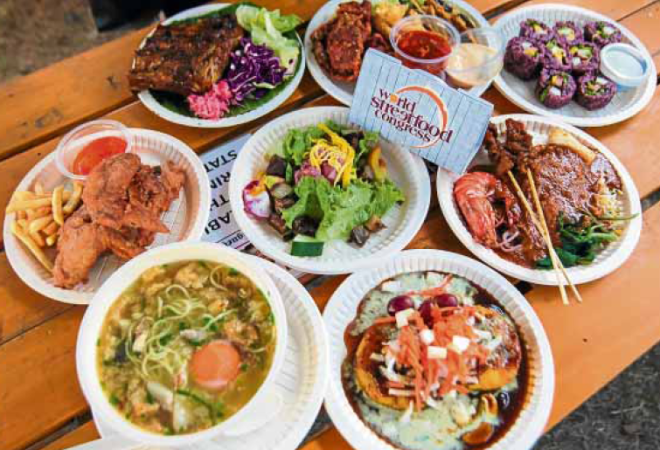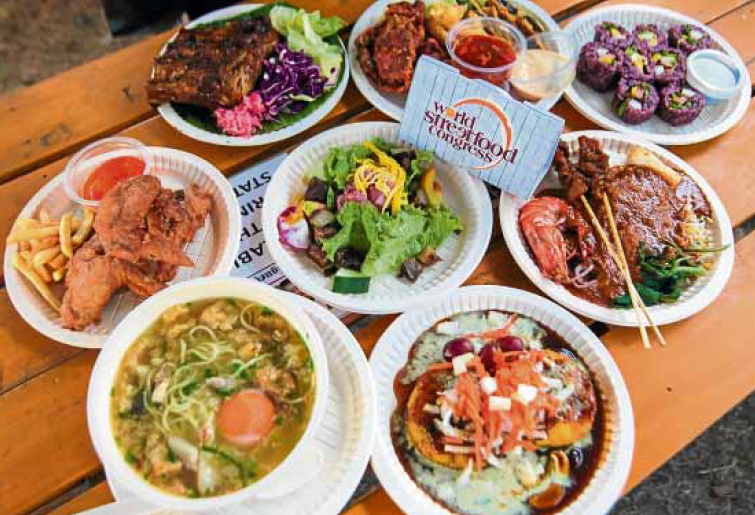
“LECHON or love life?” a girl in a cropped top asked her friend who readily replied: “Lechon!”
Fortunately, choosing among the scores of dishes offered at the World Street Food Jamboree was as easy: “Try them all!” seemed to be the default mode of diners who packed the jamboree’s tent venue at the corner of Federacion Drive and 9th Avenue at Bonifacio Global City (BGC).
Now on its last day, the World Street Food Jamboree was established in Singapore in 2013 by KF Seetoh, the chef who created the Makansutra Street Food Village.
Seetoh has been promoting street food “as part of a country’s culture, industry and tourism,” and has been pushing to make hawker food accessible to people in a central venue. The Singaporean chef chose over 20 representatives from Singapore, Indonesia, Malaysia, Vietnam, Thailand, India, China and the United States.
The six booths representing the Philippines were curated by the Tourism Promotions Board of the Department of Tourism, with each booth highlighting local flavors and cooking techniques.
Held for the first time outside Singapore, this year’s street food jamboree opened on April 20 and had for its theme, “Comforting Flavors of Home.”
‘Lechon’ with truffle rice
And the flavors indeed spoke of all corners and nuances of home, from northern Luzon to southern Mindanao for the Philippines.
There was lechon stuffed with truffle rice at Pepita’s Kitchen booth, so good that the day before, 10 whole lechon de leche were sold out way before the event closed for the night, said chef Dedet de la Fuente, creator of the dish.
“It’s ordinary lechon cooked over charcoal, but stuffed with something new and exciting—truffle oil-infused rice,” she said, adding that “Filipinos love rice and we eat it with everything.” The lechon is spiked with crushed labuyo (bird’s eye chili) sauce to cut the richness.
The North Luzon booth served kiniing-inapoy binungen, a sushi roll made of Cordillera sticky mountain rice, kiniing or smoked pork, and strips of cucumber, egg and lettuce, a recipe by chef Charlynne M. Buangan.
“It is dipped in light soy sauce with a squeeze of calamansi and some chili,” added Buangan, operations manager of Green Pepper restaurant in Baguio City.
She also served okoy tikyosko, round shrimp fritters dipped in sumayet sugarcane vinegar, as well as panara, empanada-like pastries stuffed with shredded green papaya, shrimps, crab meat, garlic and onions.
‘Kiping’ chips
For South Luzon, chef Alfonso Rafael Jose Ranido made crunchy chips out of dried cassava from Nagcarlan, Laguna, and kiping, the colorful rice wafers used as embellishments during Lucban’s Pahiyas festival. A side of chili con carne with Lucban longganisa came with the chips.
“I also combined ingredients from the Calabarzon (Cavite, Laguna, Batangas, Rizal, Quezon) and Mimaropa (Mindoro, Marinduque, Romblon, Palawan) areas, and made a kebab of grilled Lucban longganisa with tangy burong mangga (pickled mangoes) and singkamas (turnips) fermented in lambanog (coconut whisky),” Ranido added.
Over at the Bicol booth, chef Andhie Nacion served two fiery dishes: Bicol express wellington and pasta Bicolandia. The first is Nacion’s take on the traditional British beef wellington, but using stewed pork slices in coconut milk and chillies instead of beef. The pork mix was wrapped in a crisp puff pastry and topped with a sweet pumpkin puree and salted egg to balance the heat.
For his pasta Bicolandia, Nacion made a creamy sauce with spicy gata as base, and mixed in crumbled Guinobatan longganisa, garlic and malunggay (moringa).
‘Guinamos’
While homegrown Filipino chefs Claude Tayag and Sau del Rosario drew a sizeable crowd with their cooking demos, the Visayas booth had its own following with its offering of piping-hot La Paz batchoy flavored with guinamos, a native bagoong (shrimp paste) that gives the broth a salty kick. Despite the heat, diners made a beeline for the dish.
“The broth is from slow-cooked pork head, spleen, kidney and liver,” explained chef Dennis Jay Uy. Before serving, he cracked an egg atop the noodle soup, and sprinkled it with chicharon (pork crackling) and chopped spring onions.
For some Mindanao street food with a twist, check out the sinuglaw salad by chef Clinton Gregorio of Davao City.
The appetizer made of cubed grilled pork belly and tuna kinilaw (ceviche) was transformed into a salad by being served over green mango slices, cucumber, tomato and salted egg. Satti or grilled chicken skewers in sweet-and-sour sauce, a Zamboanga staple, were also offered.
For dessert, Gregorio served an exotic custard called durian-biasong panna cotta. Biasong, he explained, is a smaller and stronger variety of dayap (local lime), which neutralizes the smell of the durian.
Open at noon
At least 12,000 people a day crowded the event, said Javier Hernandez, assistant vice president for commercial business group of Ayala Land, which cosponsored the hawker fest with Makansutra. The huge turnout forced the sponsors to limit entry on peak hours, a disappointment to many.
“It’s for everyone’s security; We cannot have 20,000 people inside the jamboree at the same time,” explained Hernandez. “We had to wait for some people to leave, before letting the others come in,” he added.
Today, on the event’s last day, gates open at noon to accommodate more people, Hernandez said.
The overwhelming crowd may prompt one to ask: What makes street food so special?
Explained Seetoh: “They’re mostly heirloom family recipes that the sellers have been cooking forever, and it’s usually something you don’t cook at home.” He added: “It also reminds you of places you’ve traveled to, or your childhood.”
Among the offerings Seetoh recommended was the Singaporean dish seafood tempura with three dips from Keng Eng Kee booth. The plate of deep-fried softshell crab, calamari and eggplant came with a chili crab dip, a black pepper dip and a salted egg yolk sauce.
Also from Singapore was the satay beehoon with barbecue sticks—soft rice noodles blanched in rich peanut sauce, topped with prawn, greens and two sticks of chicken satay. The item is from Alhambra Padang Satay menu, a hawker shop that has been around for over 50 years.
Vegetarian fare
Diners strolling around were easily enticed by the smoky barbecue smell of Bali BBQ ribs from the Indonesian booth. Warung Sunset Indonesian grill had apparently perfected the recipe for tender baby-back ribs with caramelized glaze, using the kecap manis (sweet soy sauce) and spicy sambal.
For vegetarians, the hawker food festival served several items, among them golgappa, deep-fried unleavened bread balls filled with tamarind chutney, chili, potato, onion and chickpeas from India’s Satpal Chaat Bhandar booth. There was also The Cinnamon Snail, a US food truck, that served smoked chili grilled tofu bao, a soft sandwich with sautéed kimchi, pickled onion and sambal cream.
Jamboree diners
As the diners lapped up food demos by Peter Lloyd from the UK and William Wongso from Indonesia, and listened to bands and DJs as they kept the entertainment flowing at the event, they also took note of other worthy dishes, among them: Penang assam laksa by Wan Dao Tou of Malaysia; banh xeo crispy seafood pancake from Bahn Can 38 of Vietnam; Chocolate murtabak pancake pie topped with eight types of chocolates and sprinkles from Indonesia; and churro sundae from Churros Locos US.
For today’s jamboree diners, Seetoh dished out this advice: “Go in a group to try more food, split the dishes and share. Don’t ask the sellers about their food while they’re working because you’ll hold the line. Grab a beer, it’s the best match to your street food. Chat. Socialize. You might just meet someone who loves food as much as you do.”









































